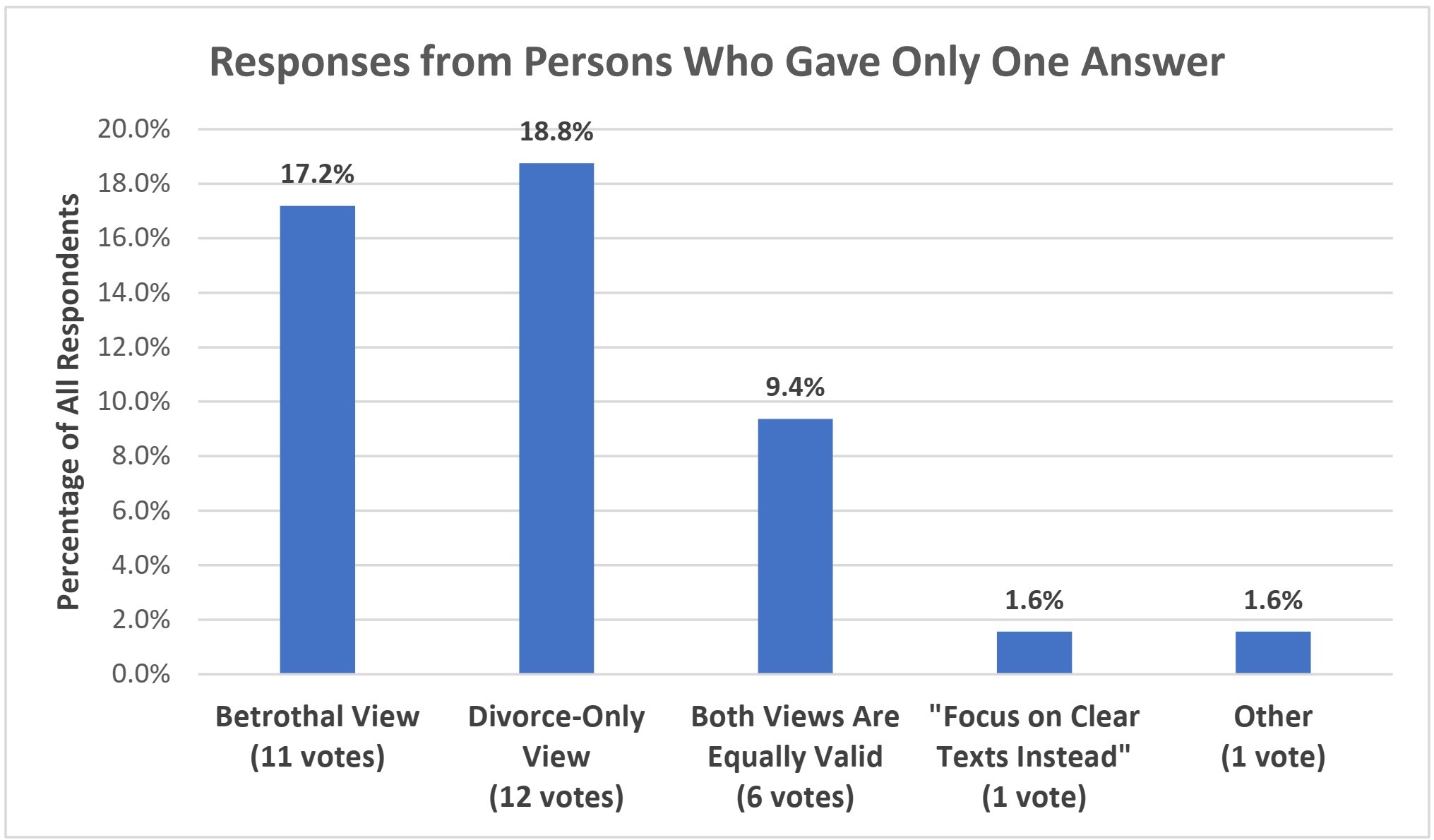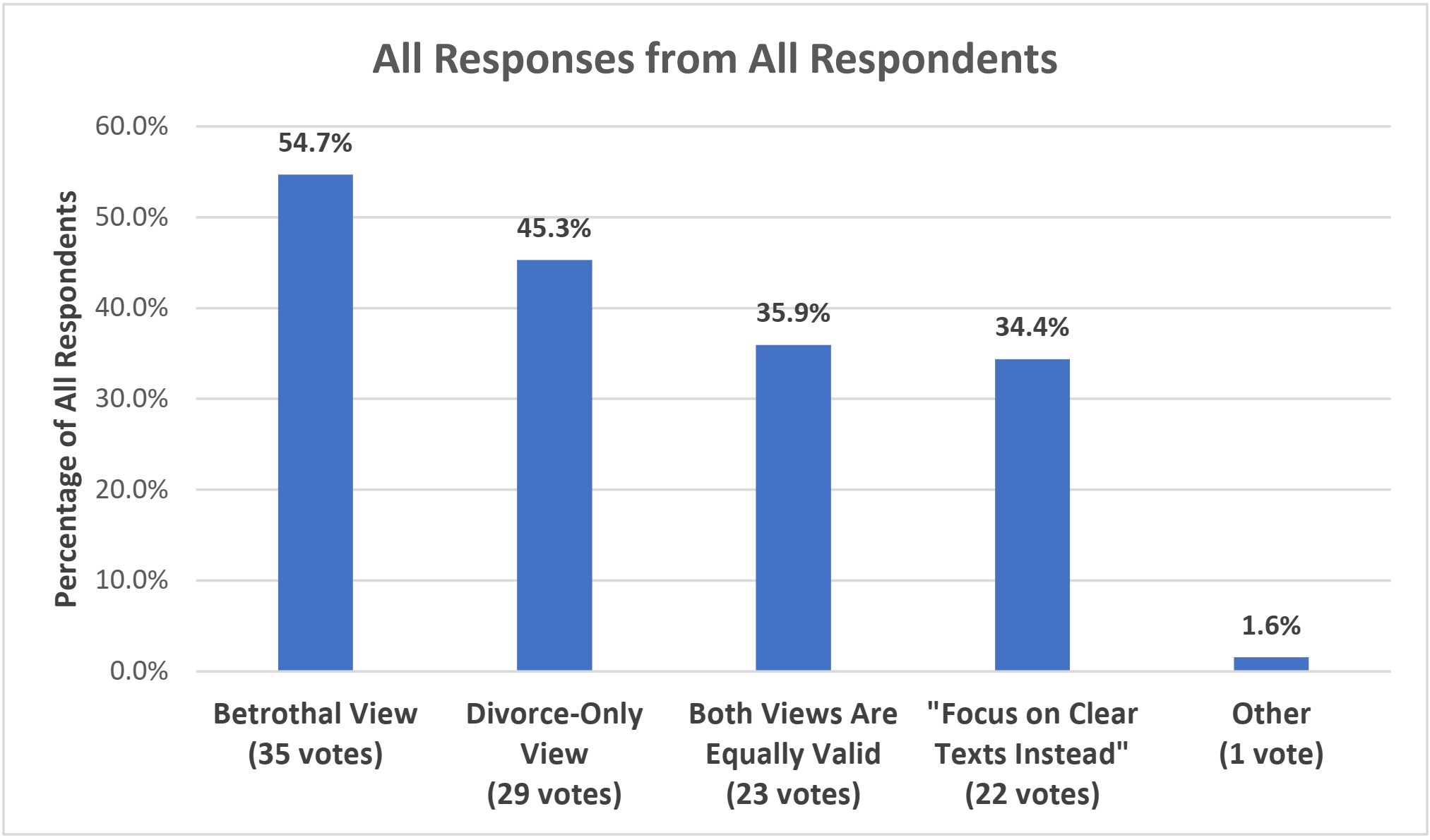This post continues my series on Jesus, divorce, and remarriage. In this series I am studying Jesus’ words with one question foremost: Did Jesus believe that marriage is indissoluble—that nothing besides death can truly end a marriage? Here are the posts in this series so far:
Jesus on Divorce and Remarriage: Introduction (JDR-1)
Hyper-Literalism, Could vs. Should, and a Guiding Question (JDR-2)
“Cleave” Does Not Imply an Unbreakable Bond (JDR-3)
Summary of this post: In this post I will argue that “one flesh” in Matthew 19:5-6 does not indicate that marriage is a bond that can be broken only by death. Paul’s use of this term in 1 Corinthians 6:16 to refer to union with a prostitute shows that a one-flesh relationship is not necessarily permanent. In fact, one-flesh oneness can occur both in unions which should never be broken (Eph. 5:31) and in unions which must be broken, no matter how entangling (1 Cor. 6:16). One-flesh language in Paul and elsewhere should be understood to emphasize the unavoidable depth of a sexual union, not its unavoidable duration.
Introduction and Assertions that One Flesh Indicates Permanence
When Jesus responded to the Pharisees’ challenge about divorce, he quoted Genesis 2:24 as a foundational text about God’s design for marriage:
Therefore a man shall leave his father and his mother and hold fast to his wife, and the two shall become one flesh. (Matt. 19:5)
Immediately after quoting this text, Jesus emphasized its final clause: “So they are no longer two but one flesh” (Matt. 19:6). One flesh is a term that raises a lot of questions and varied interpretations. I discussed the term in a general sense in a past blog post,[1] but here I’ll focus on one question: Does one flesh imply permanence?
Some Bible teachers argue that a one-flesh union is inseparable. In addition, some argue that a one-flesh union is possible only in a person’s first marriage; only in a validly-contracted marriage does God join a couple together into a permanent, one-flesh union. The hugely-influential Mennonite book Doctrines of the Bible (1928), edited by Daniel Kauffman, put it like this:
The fact is that when two are married they are “one flesh” as long as both live, and during this time neither can become “one flesh” with some one else. To assume to do so makes both adulterers…[2]
In this thinking, one flesh virtually means one person, so separation is truly impossible.[3] Some have even compared a one-flesh marriage to scrambled eggs, asserting that a true one-flesh marriage can’t be unscrambled.
Andrew Cornes is one scholar who seems to think that one flesh indicates an unbreakable bond. He emphasized that “become one flesh” (Gen. 2:24) does not describe a “process” but an “accomplished fact”:
The first thing to emphasize is that the expression is passive… It is not something which a couple can or should do; it is something which happens to them… The consummation of their marriage is part of what causes this to happen, and obviously they can choose to consummate their marriage or refrain from doing so. Nevertheless it is not they who make themselves one flesh… St Paul does indeed say that sexual intercourse is (at least to some extent) the catalyst which brings about this change into one flesh. But the change itself—the “being one flesh”—is certainly broader than that. It is not that husband and wife are one flesh when they are sexually united and cease to be one flesh when their bodies are apart. In marriage they become, permanently, one flesh.[4]
I agree, at least in part, with most of what Cornes said here. It may indeed be true that the Hebrew grammar of Genesis 2:24 implies that God is the ultimate active agent in uniting man and woman as one flesh.[5] It may also be true that the verse depicts becoming one flesh as an accomplished fact, not a process. Neither of these points, however, proves Cornes’ assertion that a married couple are “permanently” one flesh.
Joseph Webb argued even more strongly for both God’s agency and the permanence of all one-flesh relationships:
Only God can create a “one flesh” relationship between two persons. Know further that this “one flesh” condition is created through the making of a vow, and is called covenant for life; which can only be broken by the physical death of one of the partners… Sex relations do not establish the “one flesh” relationship.[6]
Gordon Wenham was equally strong in his assertions:
The Creator himself had created man in two sexes so that when they meet, they become one flesh, that is, as closely related to each other as brother and sister or parent and child. These are relationships that cannot be undone. By this appeal to Genesis, Jesus transposed the debate to a different key. Divorce was not possible under certain circumstances defined by some rabbi; it was impossible because it clashed with the Creator’s intentions in creating marriage. Genesis makes traditional divorce impossible. The divorced couple, though separated from each other, are still related to each other in the one-flesh union.[7]

Paul’s Use of One Flesh in 1 Corinthians 6
The most obvious biblical challenge to these claims is Paul’s use of one flesh in 1 Corinthians 6:16:
Do you not know that he who is joined to a prostitute becomes one body with her? For, as it is written, “The two will become one flesh.”
Paul’s words here challenge at least two assumptions of the authors quoted above.
First, it challenges the idea that becoming one flesh is primarily a passive experience. Did Paul believe that God alone creates a one-flesh union between a man and a prostitute? Isn’t Paul’s emphasis here quite the opposite—that humans can form one-flesh relationships even in the briefest of vow-less unions? Isn’t he emphasizing human responsibility for these unions? True, it is God’s creation design that causes a sexual act to result in a one-flesh union, but humans must give account for initiating one-flesh unions.
Second, as I mentioned in my last post, Paul clearly expects and urges separation of such one-flesh unions when they occur with prostitutes. He does not think they are indissoluble. He does not think that anyone who once becomes one flesh with a prostitute is now bonded for life to her, obligated to give her the full rights of marriage. Rather, he says that those who engage in such immorality can be “washed” and “sanctified” (1 Cor. 6:9-11). Paul’s usage shows clearly that one-flesh relationship is not necessarily permanent.
Webb’s Rereading of Paul
Webb disliked this reading of one flesh in 1 Corinthians 6:16 so much that he proposed an interpretation of the passage that I’ve never seen anywhere else: He asserted that Paul is forbidding Christians not from visiting prostitutes, but from marrying them!
In 1 Corinthians chapter 6, Paul was not saying that sex relations make “one flesh,” but rather that the joining of a man to a woman, by their vows, makes them “one flesh,” even if she is a harlot… Somehow, we must remove from the church’s teaching the concept that sex creates the one flesh relationship. 1 Corinthians 6:16 is the only verse, when misinterpreted, that even suggests such a thing. God’s Word only uses the phrase, “one flesh,” when it is speaking of marriage; not an illicit affair… Know that if you marry, even a harlot, you become one flesh with her![8]
I find this interpretation of Paul simply unbelievable. From a cultural perspective, it was extremely unlikely that either a Jewish or a Greco-Roman man would ever be tempted to marry a prostitute. A prostitute would, by definition, be an adulterous wife.[9] In both Jewish and Roman culture of the time, a wife’s adultery was automatic reason for a man to divorce her—in fact, he was virtually obligated to do so.
On the other hand, it was perfectly culturally acceptable for Greco-Roman men, including husbands, to frequent prostitutes. It was this common practice that Paul warned against in this passage, not some hypothetical temptation to marry prostitutes.

Does One Flesh = One Body?
Others try to preserve their belief that one flesh refers only to indissoluble unions by another method: they deny that Paul applies the term to unions with prostitutes at all. Paul says that a person who is united with a prostitute becomes “one body” with her, they note. One body, they assert, is different from one flesh; a one-body union can be broken, but a one-flesh union cannot.
I have seen this argument on Facebook, and one author who asserted the same is Raymond Ortlund, Jr.:
The one who joins himself to a prostitute enters into a ‘one body’ connection with her. It falls short of, but nevertheless approaches, mimics and violates, the full, ‘one flesh’ union of marriage. It does not create ‘one flesh’, for all that that means; but it does draw a man and a woman into intimacy which properly belongs only to the marriage bond…
Pace some commentators, I cannot dismiss Paul’s change of language from ‘one body’, as his description of a relationship with a whore, to ‘one flesh’, which his allusion to Gn. 2:24 requires, because the marriage relationship of one flesh, bringing a man and woman together for life, is of another, higher order than a merely sexual encounter. Paul, the master theologian, chooses his words carefully.[10]
Why did Ortlund insist one body means something different from one flesh? Did he provide any arguments from Paul’s vocabulary usage, his sentence structure, or any other observable data in this passage? No, the only reason Ortlund offered here is “because the marriage relationship of one flesh, bringing a man and woman together for life, is of another, higher order.”[11]
In other words, Ortlund came to Paul’s text with the assumption that one flesh is a loaded term, referring only to relationships that last “for life.” But this assumption is the very question we are testing: Is there a basis for assuming that one flesh necessarily includes the idea of a relationship being indissoluble?
Contary to Ortlund’s assertion, Paul’s usage shows that he considered one flesh and one body to be virtually equivalent terms, with neither implying permanence.
First, note that body is Paul’s default term for the entire discussion, occurring eight times in 1 Corinthians 6:12-20. It best fits both his general discussion of bodily purity and his imagery of being members of Christ. It is also the term Paul will use in the next chapter, as he discusses the sexual obligations that husbands and wives owe each other (1 Cor. 7:4). The term one flesh never occurs in that chapter about marriage. Thus, body is Paul’s default term in these chapters, carrying neither positive nor negative connotations, suitable for discussing any kind of sexual relationship.
Second, the logic of Paul’s argument ties one body and one flesh very tightly together. Within this discussion about bodily purity, Paul cites the Genesis 2:24 “one flesh” statement to prove his warning about becoming “one body” with a prostitute. How can we know a man “becomes one body with” a prostitute? Because the Bible says “the two will become one flesh.” This tight logic shows that Paul was using both terms to refer to the same basic reality, even if body and flesh may each carry some unique connotations on the side.
Third, just as Paul uses both body and flesh in this passage to refer to union with a prostitute, so he uses both terms in Ephesians 5 when discussing the intimate oneness of a husband and wife:[12]
Husbands should love their wives as their own bodies. He who loves his wife loves himself. For no one ever hated his own flesh, but nourishes and cherishes it, just as Christ does the church, because we are members of his body. “Therefore a man shall leave his father and mother and hold fast to his wife, and the two shall become one flesh.” (Eph. 5:28-31, emphasis added)
So, yes, Paul does indeed mean that a man who unites with a prostitute becomes “one flesh” with her.[13] Thus, if our conception of one flesh is to be biblical, it must fit all sorts of sexual unions, not merely marriage unions. Laney put it well:
There is no sexual intercourse which does not result in two people becoming one flesh (1 Cor. 6:16)! A married man who has intercourse with a harlot has destroyed the uniqueness of the one-flesh relationship he enjoyed with his wife.[14]
Conclusion: One Flesh Does Not Prove Permanence
According to Paul, then, the reality of a one-flesh relationship does not indicate an unbreakable bond. Rather, this one-flesh oneness can occur both in unions which should never be broken (Eph. 5:31) and in unions which must be broken, no matter how entangling (1 Cor. 6:16). One-flesh language in Paul and elsewhere should be understood to emphasize the unavoidable depth of a sexual union, not its unavoidable duration.
But is it really fair to say that just because a union with a prostitute can be broken, therefore a marriage union can also be? No, that is not a fair argument, and that is not what I am saying here. Rather, I am responding to a specific argument about what the term one flesh indicates about the permanence of any union. Paul’s use shows that the term itself does not carry any idea of necessary permanence. Therefore, if marriage is truly indissoluble, it cannot be simply because it involves a one-flesh relationship.
This is important, for some writers liberally sprinkle their teachings with expressions like “one flesh relationship,” “one person,” or “mysterious union,” often without first carefully explaining them. The abundance of such words creates a general sense that marriage must be indissoluble, even if the writer has not really proven that point. Luck pushes us to think more deeply:
Though talk is often heard of ‘personal’ unity in marriage, I have yet to hear a psychological, philosophical or biblical explanation for what this new person is and how the two individuals have ceased to be. In all marriages with which I am familiar, including happy and intimate ones, I still observe two distinguishable individuals functioning in harmony—and, if distinguishable, then perhaps separable.[15]
Jesus’ point about a man becoming “one flesh” with his wife, then, does not indicate that he believed marriage is indissoluble. Rather, he was arguing that husbands and wives who are joined so intimately should not be separated.
Thank you for reading this post. I welcome your responses! In my next post, I plan to discuss the clause “what God has joined together.” Does it imply an unbreakable bond?
If you want to support more writing like this, please leave a gift:
[1] I think I still agree with most of what I wrote, though I’d phrase some things differently now.
[2] Daniel Kauffman, ed., Doctrines of the Bible: A Brief Discussion of the Teachings of God’s Word (Scottdale, PA: Herald Press, 1928), 434.
[3] As Taylor says, “God has mysteriously joined man and wife together into one person” (Dean Taylor, “One Flesh One Covenant,” Pt. 1 of “Marriage, Divorce, and Remarriage,” The Heartbeat of The Remnant, April/May/June 2007, Ephrata Ministries, 4. Available online, accessed 4/21/2022, http://www.ephrataministries.org/pdf/2007-05-covenant.pdf).
[4] Andrew Cornes, Divorce and Remarriage: Biblical Principle and Pastoral Practice (Fearn, Scotland: Christian Focus Publications, 2002), 59-60.
[5] I am not well equipped to discuss Hebrew grammar, but the point is certainly theologically true.
[6] Joseph A. Webb, Till Death Do Us Part? What the Bible Really Says About Marriage and Divorce (Longwood, FL: Webb Ministries, 2003), 8, 27. I have removed Webb’s non-traditional use of typeface and capitalization.
[7] Gordon J. Wenham, Jesus, Divorce, and Remarriage: In Their Historical Setting (Bellingham, WA: Lexham Press, 2019), 73.
[8] Webb, ibid. I removed Webb’s non-traditional use of typeface and added italics for my own emphasis.
[9] Unless she were a former prostitute—a scenario that then makes no sense of Paul’s warnings against uniting with her. Nothing in Paul’s teaching prohibited marrying former prostitutes who had been “washed” (1 Cor. 6:9-11) and who were already united to Christ.
[10] Raymond C. Ortlund, Jr., God’s Unfaithful Wife: A Biblical Theology of Spiritual Adultery (Downers Grove, IL: InterVarsity Press, 1996), 145 and 145, n. 16. Jay Adams likewise distinguishes “one body” and “one flesh” in this passage, but without defending his distinction and without asserting that a one-flesh union cannot be broken: “In 1 Corinthians 6… Paul distinguishes three sorts of unions:
1. one body (v. 16)—sexual relations with a harlot=a close union
2. one flesh (v. 16)—the marriage union=a closer union
3. one spirit (v. 17)—union with Christ=the closest union
It is not possible here to develop this important passage further.” See Jay E. Adams, Marriage, Divorce, and Remarriage in the Bible: A Fresh Look at What Scripture Teaches (Grand Rapids, MI: Zondervan, 1980), 17. Thiselton likewise distinguishes one body as referring to union with a prostitute and one flesh as referring to marriage. But he does not defend this distinction nor consistently adhere to it. See Anthony C. Thiselton, 1 Corinthians: A Shorter Exegetical & Pastoral Commentary (Grand Rapids, MI: Eerdmans, 2006), 95.
[11] Ortlund does suggest one additional reason later, in his discussion of Ephesians 5. I will respond to that reason (via footnote 12) when I discuss the same passage below.
[12] Ortlund believes Paul uses “flesh” and “body” differently in the two passages:
It is worth nothing that, in contrast with 1 Cor. 6:16, Paul uses ‘body’ and ‘flesh’ in nearly equivalent terms here, because he is bringing together his ‘Body of Christ’ image of the church with the language of Gn. 2:24. But the categories operative in the Corinthians passage are different, as the inner logic of that passage requires. There, Paul is counting on a distinction between ‘body’ and ‘flesh’ as material to his message. The two words are ciphers for fundamentally different relationships, viz. a casual sexual encounter (‘one body’) versus marriage (‘one flesh’). There, ‘body’ is prompted by the merely physical nature of promiscuity; here ‘body’ is prompted by Paul’s image of the church.” Raymond C. Ortlund, Jr., God’s Unfaithful Wife: A Biblical Theology of Spiritual Adultery (Downers Grove, IL: InterVarsity Press, 1996), 154-55.
I have already said that I do not see Paul intending to draw a “distinction” between casual sexual encounters and marriage in 1 Cor. 6. Rather, he is noting what both have in common. I don’t think Ortlund’s second assertion (about what “prompts” Paul’s used of each term) holds, either. For one thing, Paul uses “body” rather than “flesh” in 1 Cor. 7 when discussing marriage relations, so he does not reserve that term in that letter for “the merely physical nature of promiscuity.” For another, Paul is indeed thinking about his image of the church in 1 Cor. 6, not only in Eph. 5. In 1 Cor. 6 Paul says “your bodies are members of Christ,” and in Eph. 5 he says “we are members of his body.” The “member” language in both passages shows Paul is concerned with our individual union with Christ, and “of Christ” in 1 Cor. 6 is equivalent to “of his body” in Eph. 5. Again, Ortlund’s distinctions seem motivated more by his prior assumptions about what “one flesh” must signify than by any accurate observations about Paul’s usage of terms.
[13] For what it is worth, a clear majority of recent 1 Corinthians commentators appear to agree with me on this point, including Craig Blomberg, Roy Ciampa/Brian Rosner, Gordon Fee, David Garland, Roy Harrisville, Richard Hays, Craig Keener, and Mark Taylor. As Harrisville notes, “the terms ‘body’ and ‘flesh’ in this verse are virtually synonymous, use of the term ‘flesh’ controlled by the biblical quotation from Gen. 2:24.” See Roy A. Harrisville, I Corinthians (Minneapolis, MN: Augsburg Publishing House, 1987), 101. Among commentators whose views I was able to ascertain, the only one who appeared to disagree with me was Thiselton (see previous note).
[14] Carl J. Laney, The Divorce Myth: A Biblical Examination of Divorce and Remarriage (Minneapolis, MN: Bethany House Publishers, 1981), 21.
[15] William F. Luck, Divorce and Re-Marriage: Recovering the Biblical View, 2nd ed. (Richardson, TX: Biblical Studies Press, 2008), 9-10.







